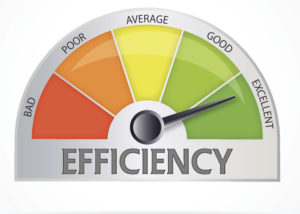By Shefali Patel, OD

May 3, 2023
Consistently delivering a high level of care while maintaining efficiency is not easy. Here are strategies that I can testify work, based on my own practice experience.
Differentiating Employee Roles & Responsibilities
The office where I practiced before my current one originally didn’t have designated roles among the employees. All employees would schedule patients, answer phones, check-in patients, set up intake forms, verify insurances, show glasses and finish optical sales. This became messy. Patients wouldn’t know who to go to when walking through the door and patients were being transferred from one staff member to another in the middle of their visit. I suggested designating specific roles to each employee as below:
- One staff member verifying insurance prior to arrival
- One staff member greeting, checking in and setting up patients with their intake forms
- One staff member answering phone calls and scheduling
- 2-3 staff members showing glasses, dispensing glasses and taking the lead on optical sales
This idea came to me after observing staff members getting flustered in the middle of their task to finish another task. Staff were dispensing glasses, but would receive a phone call and put the call on hold OR they would be showing glasses and greeting those walking through the door at the same time. I felt this was making the patient experience impersonal, patients were feeling rushed and the staff wasn’t focused on their specific tasks. As a result, there were many errors in optical orders (writing down the wrong prescription, forgetting to write down patients’ phone numbers, incorrect price breakdowns, which resulted in incorrect charges, etc.) and in scheduling patients (whether it be scheduling with the wrong doctor or placing it under the wrong exam title, i.g. medical visit vs. comprehensive exam vs. refraction).
Staff meetings and compliance was required to make this change. Because staff members were used to being cross-trained, there was a big adjustment period on getting each staff member to focus on their specific tasks. There also had to be an agreement among all the employees on who would be best at each role. For example, our licensed optician was previously greeting patients and checking them in, but their primary focus should have been on the optical floor – the optician should be the one making glasses in the lab, doing repairs, leading optical sales and styling. The optician agreed and started focusing solely on those tasks.
After making these changes, the patient experience became more personable. There was an overall increase in patient satisfaction as a result of better office flow. Patients would walk in and be greeted by a staff member and set up with their paperwork, which would be followed by the technician workup and then their eye exam. After their exam, the doctors would bring patients back out and get them set up with someone on the floor to help with spec styling and sales. It was efficient, but holistic.
Result: With a few staff who were in charge of nothing but optical sales, they were able to better cater to patients’ needs, pay attention to detail with price breakdown and, therefore, increase optical sales.
There also was an increase in patients scheduled because patients were being scheduled specifically as medical office visits, comprehensive visits, follow-ups, etc. I would say there was an estimated 3-5 more patients being scheduled per doctor due to our greater differentiation of staff responsibilities and greater differentiation between the different kinds of visits to our office.
Optimize Workspace to Optimize Workflow
The optical and front desk were on one side and the doctors’ space was on the other side of the office. The owner of the practice added walls around the doctor’s side of the office, but there was no clean structure, which created a lack of flow for the patients. There were frame boards on the same side as the technicians’ space, contact-lens training area and exam lanes, which meant people were looking at frames while other patients were being worked up for the doctors.
Other Articles to Explore
I implemented a separate, more private, area for contact-lens training and suggested moving the frame boards all to the optical side of the office. The store manager and I organized the technicians’ room, so all machines were lined up in the order of testing for each patient – fundus camera, AR and then NCT; lensometry was near the computer for the technician to use as needed. We moved the specialty testing – OCT, topographer, visual field – to another room, which created a less crowded, more private, environment for the technician. I felt these changes were necessary to make patients feel comfortable during pretesting, add privacy during contact-lens training and to allow doctors maintain confidentiality of patients’ health information.
Result: This change enabled us to add approximately five more contact-lens fittings to the schedule per week due to the extra space.
More Fully Utilize our Practice Management (PM) Software
Our practice management software was previously only used to input patient demographics and schedule appointments. The practice management software we had at the practice had so many more functionalities, such as a “vault” to scan in paper records directly onto the patients’ profile and create optical orders, so there would be less room for error in price quote calculations and insurance benefits. Staff members were using the PM software to schedule, but would have to also pull patients’ paper charts to give doctors access to previous exams – this was extremely inefficient. Having to shuffle through paper charts and old spec orders made no sense.
I suggested we scan all paper charts into our PM software, so all staff and doctors could access any previous records they may need for each patient. Insurance eligibility and insurance authorizations could also be done through the PM, which the staff started to learn. The store manager and assistant store manager took a course on how to optimize the PM software, and this helped greatly expand their knowledge of the technology’s practice management functions.
Results: The greater use we made of our PM software significantly reduced wait time for patients because staff was able to more quickly access previous notes or optical orders and did not have to shuffle through small invoice papers or old charts.
 Shefali Patel, OD, has practiced optometry in New Haven, Conn., for the last six years. She is currently in the process of purchasing an independent practice, which she hopes to open in the coming year. To contact her: shefali.928@gmail.com
Shefali Patel, OD, has practiced optometry in New Haven, Conn., for the last six years. She is currently in the process of purchasing an independent practice, which she hopes to open in the coming year. To contact her: shefali.928@gmail.com





















